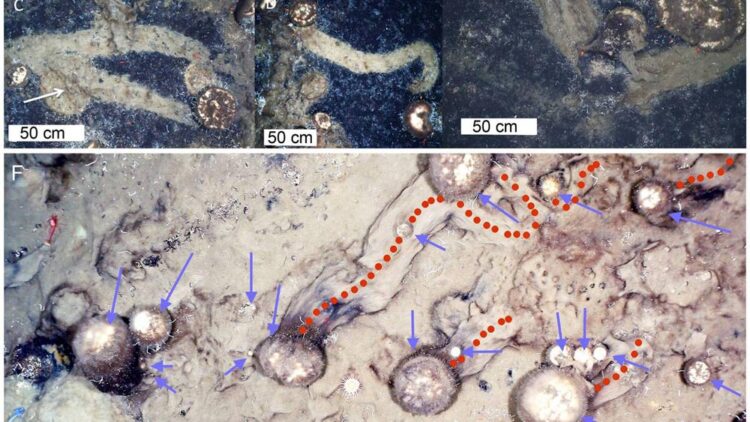Surprise in the deep sea

Source: AWI
Researchers discover sponge paths on the ocean floor…
Sponges: They are considered to be one of the most primitive forms of animal life, because they have neither locomotion organs nor a nervous system. A team around deep-sea scientist Antje Boetius has now discovered that sponges leave trails on the sea floor in the Arctic deep sea. They conclude that the animals might move actively – even if only a few centimetres per year. They are now publishing these unique findings in the journal Current Biology.
The surprise was great when researchers looked at high-resolution images of the sea floor of the Arctic deep sea in detail: Path-like tracks across the sediments ended where sponges were located. These trails were observed to run in all directions, including uphill. “We conclude from this that the sponges might actively move across the sea floor and leave these traces as a result of their movement,” reports Dr Teresa Morganti, sponge expert from the Max Planck Institute for Marine Microbiology in Bremen. This is particularly exciting because science had previously assumed that most sponges are attached to the seafloor or are passively moved by ocean currents and, usually down slopes.
“There are no strong currents in the Arctic deep sea that could explain the structures found on the sea floor,” explains expedition leader Prof. Antje Boetius, who works together with deep-sea biologist Dr Autun Purser from the Alfred Wegener Institute, Helmholtz Centre for Polar and Marine Research (AWI) in the HGF-MPG Joint Research Group for Deep-Sea Ecology and Technology. The recently published recordings were made during an expedition at 87 °North at the Karasik Seamount about 350 kilometres away from the North Pole with the research icebreaker Polarstern in 2016 with a towed camera system OFOBS (Ocean Floor Observation and Bathymetry System). “With OFOBS we can create 3D models from the deep sea. The seamount’s summit was densely populated with sponges. 69 percent of our images showed trails of sponge spicules, many of which led to live animals,” reports Autun Purser.
Many questions arise from these observations: Why do the sponges move? How do they orient themselves? Possible reasons for locomotion could be foraging, avoiding unfavourable environmental conditions, or to distribute offspring. Searching for food in particular plays a major role in nutrient-poor ecosystems such as the Arctic deep sea. Sponges have an important function there anyway. As filter feeders they can utilize particle and dissolved organic matter and are intensively involved in nutrient and matter recycling by means of their bacterial symbionts. Sponges also provide arctic fish and shrimp useful structures to use as a habitat. However, the scientists still have to investigate the mechanisms of locomotion.
Original publication:
Teresa M. Morganti, Autun Purser, Hans Tore Rapp, Christopher R. German, Michael V. Jakuba, Laura Hehemann, Jonas Blendl, Beate M. Slaby, Antje Boetius: In situ observation of sponge trails suggests common sponge locomotion in the deep central Arctic. Current Biology (2021); DOI: 10.1016/j.cub.2021.03.014
Embargoed until: 17:00 CEST on 26 April 2021 (11:00 AM US Eastern Time)
Notes to Editors:
Underwater videos and 3D footage of the ocean floor are available at this link until the embargo is lifted: https://we.tl/t-HIptpYwfc3; afterwards in the online version of this press release: https://www.awi.de/en/about-us/service/press.html
Your contact persons are
– Dr Autun Purser, tel. +49 471 4831 1740; e-mail: autun.purser(at)awi.de
– Dr Teresa Maria Morganti, tel. +34 622 920 462 or via Skype @teremo83; e-mail: tmorgant(at)mpi-bremen.de
Your contact person in the AWI’s press office is Folke Mehrtens, tel. +49 471 4831 2007 (e-mail: media(at)awi.de).
The Alfred Wegener Institute, Helmholtz Centre for Polar and Marine Research (AWI) conducts research in the Arctic, Antarctic and oceans of the high and mid-latitudes. It coordinates polar research in Germany and provides major infrastructure to the international scientific community, such as the research icebreaker Polarstern and stations in the Arctic and Antarctica. The Alfred Wegener Institute is one of the 19 research centres of the Helmholtz Association, the largest scientific organisation in Germany.
Media Contact
All latest news from the category: Life Sciences and Chemistry
Articles and reports from the Life Sciences and chemistry area deal with applied and basic research into modern biology, chemistry and human medicine.
Valuable information can be found on a range of life sciences fields including bacteriology, biochemistry, bionics, bioinformatics, biophysics, biotechnology, genetics, geobotany, human biology, marine biology, microbiology, molecular biology, cellular biology, zoology, bioinorganic chemistry, microchemistry and environmental chemistry.
Newest articles

A universal framework for spatial biology
SpatialData is a freely accessible tool to unify and integrate data from different omics technologies accounting for spatial information, which can provide holistic insights into health and disease. Biological processes…

How complex biological processes arise
A $20 million grant from the U.S. National Science Foundation (NSF) will support the establishment and operation of the National Synthesis Center for Emergence in the Molecular and Cellular Sciences (NCEMS) at…

Airborne single-photon lidar system achieves high-resolution 3D imaging
Compact, low-power system opens doors for photon-efficient drone and satellite-based environmental monitoring and mapping. Researchers have developed a compact and lightweight single-photon airborne lidar system that can acquire high-resolution 3D…





















